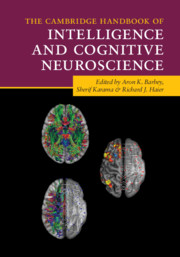Book contents
- The Cambridge Handbook of Intelligence and Cognitive Neuroscience
- Reviews
- The Cambridge Handbook of Intelligence and Cognitive Neuroscience
- Copyright page
- Dedication
- Contents
- Figures
- Tables
- Contributors
- Preface
- Part I Fundamental Issues
- Part II Theories, Models, and Hypotheses
- Part III Neuroimaging Methods and Findings
- 10 Diffusion-Weighted Imaging of Intelligence
- 11 Structural Brain Imaging of Intelligence
- 12 Functional Brain Imaging of Intelligence
- 13 An Integrated, Dynamic Functional Connectome Underlies Intelligence
- 14 Biochemical Correlates of Intelligence
- 15 Good Sense and Good Chemistry
- Part IV Predictive Modeling Approaches
- Part V Translating Research on the Neuroscience of Intelligence into Action
- Index
- References
10 - Diffusion-Weighted Imaging of Intelligence
from Part III - Neuroimaging Methods and Findings
Published online by Cambridge University Press: 11 June 2021
- The Cambridge Handbook of Intelligence and Cognitive Neuroscience
- Reviews
- The Cambridge Handbook of Intelligence and Cognitive Neuroscience
- Copyright page
- Dedication
- Contents
- Figures
- Tables
- Contributors
- Preface
- Part I Fundamental Issues
- Part II Theories, Models, and Hypotheses
- Part III Neuroimaging Methods and Findings
- 10 Diffusion-Weighted Imaging of Intelligence
- 11 Structural Brain Imaging of Intelligence
- 12 Functional Brain Imaging of Intelligence
- 13 An Integrated, Dynamic Functional Connectome Underlies Intelligence
- 14 Biochemical Correlates of Intelligence
- 15 Good Sense and Good Chemistry
- Part IV Predictive Modeling Approaches
- Part V Translating Research on the Neuroscience of Intelligence into Action
- Index
- References
Summary
Since the dawn of intelligence research, it has been of considerable interest to establish a link between intellectual ability and the various properties of the brain. In the second half of the nineteenth century, scientists such as Broca and Galton were among the first to utilize craniometry in order to investigate relationships between different measures of head size and intellectual ability (Deary, Penke, & Johnson, 2010; Galton, 1888). However, since craniometry can at best provide a very coarse estimate of actual brain morphometry and adequate methods for intelligence testing were not established at that time, respective efforts were not particularly successful in producing insightful evidence. About 100 years later, technical developments in neuroscientific research, such as the introduction of magnetic resonance imaging (MRI), enabled scientists to assess a wide variety of the brain’s structural properties in vivo and relate them to cognitive capacity. One of the most prominent and stable findings from this line of research is that bigger brains tend to perform better at intelligence-related tasks. Meta-analyses comprising a couple of thousand individuals have reported correlation coefficients in the range of .24–.33 for the association between overall brain volume and intelligence (McDaniel, 2005; Pietschnig, Penke, Wicherts, Zeiler, & Voracek, 2015). A common biological explanation for this association is the fact that individuals with more cortical volume are likely to possess more neurons (Pakkenberg & Gundersen, 1997) and thus more computational power to engage in problem-solving and logical reasoning.
- Type
- Chapter
- Information
- Publisher: Cambridge University PressPrint publication year: 2021

